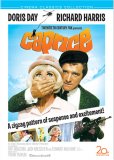| Reviews & Columns |
|
Reviews DVD TV on DVD Blu-ray 4K UHD International DVDs In Theaters Reviews by Studio Video Games Features Collector Series DVDs Easter Egg Database Interviews DVD Talk Radio Feature Articles Columns Anime Talk DVD Savant Horror DVDs The M.O.D. Squad Art House HD Talk Silent DVD
|
DVD Talk Forum |
|
|
| Resources |
|
DVD Price Search Customer Service #'s RCE Info Links |
|
Columns
|
|
|
Caprice
I had a rather grumpy opinion the first time I saw Caprice, the much-maligned 1967 spy spoof starring Doris Day and Richard Harris. Doing research on my spy book, and watching a bootlegged panned-and-scanned videotape of it supplied to me by a friend who lived in England (it's never been released on U.S. video), Caprice came off as disjointed and unfunny to me at the time, with the poor quality of the videotape not helping any in my negative assessment of the film. Seen now, as part of a three film, 20th Century Fox Cinema Classics Collection starring Doris Day (Move Over, Darling and Do Not Disturb are the other two -- click on the titles to see my reviews), Caprice looks light-years better, in a meticulously restored CinemaScope print. I was more receptive to the film's quirks this time, too (maybe I had bottomed out after wading through over 1700 spy films), but there are still big problems with Caprice. It's certainly enjoyable, but it's not the neglected, misunderstood masterpiece that some critics would have you believe.
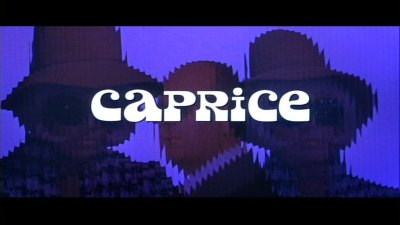
Doris plays Patricia Foster, an industrial spy for cosmetics manufacturer Sir Jason Fox (Edward Mulhare). Through a complicated series of set-ups, Patricia makes herself available to rival firm May Fortune Cosmetics, headed by Matthew Cutter (Jack Kruschen). Evidently, Cutter is ready to release a revolutionary hair spray that keeps hair dry even when swimming. Day's mission is to get the formula and return it to Sir Jason. Working against her (or with her?) is Christopher White (Richard Harris), an associate of Cutter who tries to keep Patricia away from the formula. Chemist Stuart Clancy (Ray Walston) is the shadowy, faintly unhinged "mad scientist" who may or may not be behind the revolutionary formula, and Su Ling (Irene Tsu) is the beautiful model who also plays a part in tracking down the hair spray known as "Caprice."
I only recounted the very bare bones of Caprice's plot, so as not to spoil it for the uninitiated, but truly, the complicated cross and double-cross plot only serves as a framework for director Frank Tashlin's trademark set pieces. The problem with those Caprice set pieces - regardless of how well they're done - is that they're two of a different kind: spoof and serious spy thriller. Aiming, I believe, to recapture the spirit of Charade and Arabesque, rather than Fox's spy spoofs Our Man Flint and In Like Flint, Caprice wants to switch tone from serious action piece to silly slapstick, from dramatic, romantic scenes to comedic, farcical ones, as Charade and Arabesque did effortlessly (the Flint movies were pure spoofs - there were definitely no deliberately serious scenes, as with Caprice). But the seams between the two tones are a mile wide; they don't mesh properly, and the film veers wildly off course every ten minute or so when a good, solid dramatic sequence is followed by a very funny, expertly executed Frank Tashlin comedy scene.
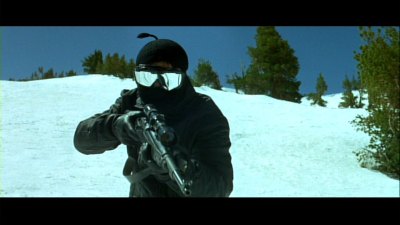
Tashlin, who prior to his successful motion picture career with Jerry Lewis and other film projects (Will Success Spoil Rock Hunter?, The Girl Can't Help It) worked in the Warner Bros. animation department, obviously knows how to set up a gag. And many comedy scenes in Caprice bear the unmistakable Tashlin energy and rhythm. The apartment sequence, where Day and Harris are chased through various levels by the cops, is quite funny (Doris' little bowler hats remind me of Harry Langdon's stock costume), and Doris' big set piece, where she tries to clip a lock of Tsu's hair, and winds up hanging off the bottom of a precipitous sun deck, is brilliantly constructed and surely executed. Tashlin's penchant for twisting his own filmic elements is on display in the funny sequence where Doris is trying to thwart a microphone hidden in a sugar cube. Tashlin's exaggerated sound effects (something Jerry Lewis borrowed for The Nutty Professor) are an hilarious counterpoint to the sequence, culminating in an off-screen belch from Day that's a comedic highpoint of the film.
But other comedy set pieces fail, including a shark sequence that turns out to be a lame Flipper in-joke, while many of the supposedly light comedy/romance sequences fail to find their correct metier. Tashlin's serious sequences work well, too, but they have no relation to the comedy ones. A fabulous ski sequence involving Doris and an assassin is as well executed as any Bond scene from the 1960s, but it anchors a serious, downbeat third act of a film that doesn't know whether it's a comedy, spoof, or serious spy work -- and ultimately, neither does the viewer. Caprice is at least two films spliced together, and while individual scenes in the film work extremely well on their own, the mix does not, leaving you with a frustrated feeling that the director missed hitting his mark, while coming agonizingly close to creating something truly special.
Famously, Doris Day remarked in her autobiography that Caprice was her least favorite film. While I certainly don't think it's anywhere near her worst film, I can imagine its critical failure was particularly stinging to Day, considering it marked the end of her audiences' unconditional love affair with the star. The Ballad of Josie, a pallid Western comedy co-starring Peter Graves, had come out four months before Caprice, and it was not well received. Caprice proved even more unpopular with the critics (and there's some debate as to whether it was successful at the box office), with the media, for the first time, openly questioning Day's place in a rapidly changing film industry. Of course, as many film fans know, the year Caprice came out was the same year that the hugely influential The Graduate premiered - a film that was designed with Doris Day in mind for the part of Mrs. Robinson (Day asserted she turned it down for moral reasons, but many feel her husband/agent/manager Marty Melcher did so without telling her). Regardless of how Day may have felt about the moral content of The Graduate, the fact was that in 1967, she was making Grade B spy spoofs (already rapidly going out of fashion that year), while a role custom tailored for her, but which she turned down, was causing a sensation all over the world, and which would have, in all likelihood, reinvented her movie career.
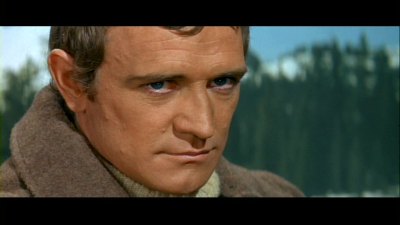
Harris is certainly an interesting addition to the pantheon of Day co-stars, bringing a definite English mod appeal, with a dash of "angry young man" charm thrown in, too. But I'm not sure their chemistry entirely works on screen (they reportedly enjoyed working together). Harris, at this point wanting to cash in on his new found celebrity (This Sporting Life was an international sensation), was coming to Hollywood to make money, and it would seem he thought starring in a Doris Day comedy would expose him to a new audience. And while Harris is good in comedy, something just doesn't jell between them on screen. It's difficult to describe -- as it is when stars mesh perfectly on screen -- but something is off with them -- perhaps it was, as they both said later, the fact that neither one of them knew, from one day to the next, exactly what kind of movie they were making.
It's curious to watch Day here in Caprice. She's such an instinctive, natural actress that you really believe her in her scenes, regardless of the scene's worth. And she's quite good in the film's more serious moments, lending them a weight that, while admirable, further pulls the film out of kilter alongside the broad, gag-filled comedy sequences. The actress that Hitchcock didn't need to direct because she was so good, is still evident in Caprice, but the sight of Doris (or rather her stunt double) rolling down a hill, and then getting covered in mud, all at the service of a rather slight little spy romp, is ultimately depressing. Day shows what a good sport she is, despite the silly things she's forced to do in Caprice, but that's the last thing we need to see from her at this point in her career. It's not surprising she disliked Caprice so much.
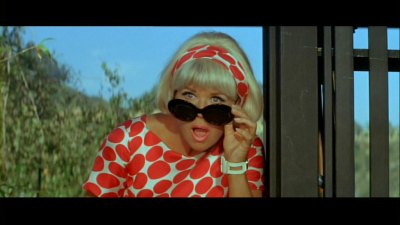
The DVD:
The Video:
Of the three new Doris Day Fox DVD releases, Caprice was given the most attention, and the most hours of restoration work, and the results are nothing short of spectacular. Tashlin's eye for Pop Art and Op Art background designs are well served in the wide, wide 2.35:1, anamorphic CinemaScope transfer here, helping the viewer get many of Tashlin's jokes that would have been cut off in a pan-and-scan image.
The Audio:
There are two Dolby Digital English audio options available for Caprice: a 2.0 stereo version (which is quite active), and the original mono track. French and Spanish mono tracks are also available. English and Spanish subtitles are available, as well as close-captioning.
The Extras:
There's an amazing amount of extras for Caprice, starting with a full length commentary track by film historian John Cork and Doris Day fan Pierre Patrick. While Cork admits right up front that Caprice is a "fun" film (read: not really deserving of a too-heavy reading), he has some interesting points to make about the film, which you may or may not agree with (some I did, some I didn't). But often, irrelevant trivia is brought up by Patrick, stymying Cork's points. The Caprice Look: A Conversation with Costume Designer Ray Aghayan is a fascinating five minute look at the process by which the famed designer came up with the film costumes' singular look. Double-O Doris is a fun, six and a half minute look at Caprice's place in the spy spoof genre, while Doris and Marty is a fairly honest, eleven minute look at the relationship between the star and her husband/agent/manager. Also included are radio interviews with Doris and Richard Harris which are quite interesting -- especially when you realize that upon completion, Doris hated this film, and only agreed to do the barest minimum of promotion for it. The restoration comparison that's on the other two DVDs is here, as well as a good photo gallery, and trailers for this film and the other two Day Fox films.
Final Thoughts:
Looking back on Caprice now, I'm still having difficulty coming to grips with it. So much of it is so startlingly good, that I want to say it's better than it really is. But you leave the film thoroughly frustrated with its choppy construction and wild mood swings; and it winds up as definitely less than the sum of its parts. Perhaps it's been wildly overpraised lately because it's been next-to-impossible to see, and it looks so good next to the dreck that Day ended her movie career with; Caprice at least tried for something different -- something that can't be said for forgettable junk like The Ballad of Josie and Where Were You When the Lights Went Out. Whether or not Caprice succeeded at that is another matter. But I do recommend you check it out, especially if you're a Doris Day and/or spy movie fan.
Paul Mavis is an internationally published film and television historian, a member of the Online Film Critics Society, and the author of The Espionage Filmography.


|
| Popular Reviews |
| Sponsored Links |
|
|
| Sponsored Links |
|
|
| Release List | Reviews | Shop | Newsletter | Forum | DVD Giveaways | Blu-Ray | Advertise |
|
Copyright 2024 DVDTalk.com All Rights Reserved. Legal Info, Privacy Policy, Terms of Use,
Manage Preferences,
Your Privacy Choices | |||||||









